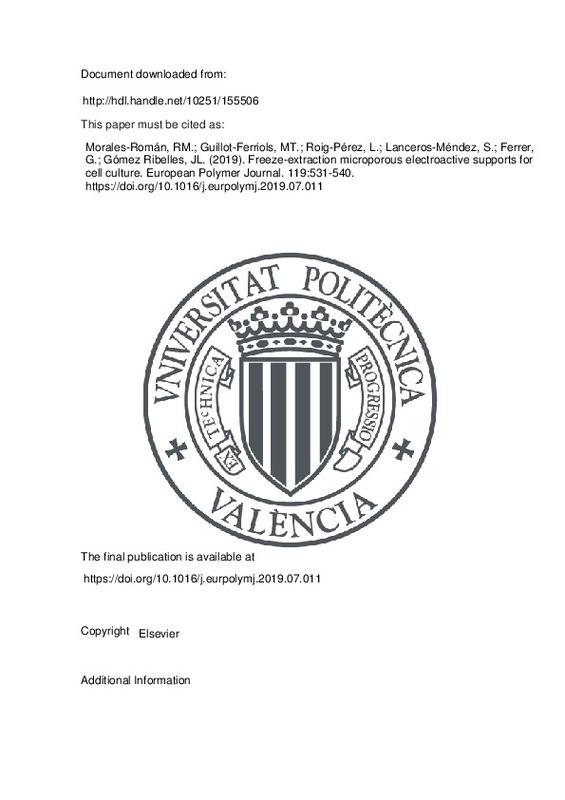JavaScript is disabled for your browser. Some features of this site may not work without it.
Buscar en RiuNet
Listar
Mi cuenta
Estadísticas
Ayuda RiuNet
Admin. UPV
Freeze-extraction microporous electroactive supports for cell culture
Mostrar el registro sencillo del ítem
Ficheros en el ítem
| dc.contributor.author | Morales-Román, Rosa María
|
es_ES |
| dc.contributor.author | Guillot-Ferriols, María Teresa
|
es_ES |
| dc.contributor.author | Roig-Pérez, L.
|
es_ES |
| dc.contributor.author | Lanceros-Méndez, S.
|
es_ES |
| dc.contributor.author | Gallego-Ferrer, Gloria
|
es_ES |
| dc.contributor.author | Gómez Ribelles, José Luís
|
es_ES |
| dc.date.accessioned | 2020-11-24T04:32:03Z | |
| dc.date.available | 2020-11-24T04:32:03Z | |
| dc.date.issued | 2019-10 | es_ES |
| dc.identifier.issn | 0014-3057 | es_ES |
| dc.identifier.uri | http://hdl.handle.net/10251/155506 | |
| dc.description.abstract | [EN] Poly(vinylidene fluoride) (PVDF) is a semicrystalline polymer with four crystalline phases, of which the all trans conformation (beta-phase) is the one with the largest piezoelectric response and best electroactive properties. This smart material is able to reproduce physiological events such as inherent bone piezoelectricity, making it a perfect candidate to drive the osteogenic differentiation of mesenchymal stem cells (MSCs) towards the osteogenic lineage. The influence of topography on the adhesion, proliferation and maintenance of multipotency of this type of cell is well established and has confirmed that the production of variable porosity substrates is a suitable approach for cell therapy. In this work, novel PVDF microporous membranes in the beta-phase were developed by the freeze-extraction technique. Several concentrations of PVDF in N,N-dimethylformamide (10, 15 and 20% w/v) were used to obtain membranes with different grades of porosity in the range of 80-84%. The cell culture supports thus produced were found to possess good crystallinity (66%), beta-phase presence (94%) and a microstructure based on spherulite agglomerations with a diameter of spherulite in the order of 1 mu m that is higher as the polymer concentration increases. The membranes have good mechanical properties and the storage modulus, with values between 5 and 47 MPa, rises with the polymer content of the starting solution. Porcine bone marrow mesenchymal stem cells (pBM-MSCs) were used to study cell adhesion and proliferation. Regarding cell adhesion at 24 h, the cells preferred the more porous structures and had round focal adhesions with well-developed cytoskeletons, while they had a round morphology on the less porous membranes. The cells preferred the less porous membranes to proliferate, even though the initial morphology at 24 h showed poor adhesion. These findings confirm that the controlled microporosity of beta-phase PVDF membranes can be produced by freeze extraction and offer the possibility of modifying the adhesion and proliferation of pBM-MSCs on these substrates. | es_ES |
| dc.description.sponsorship | This work was supported by the Spanish Government through Projects MAT2016-76039-C4-1-R and MAT2016-76039-C4-3-R (including FEDER funds). Maria Guillot-Ferriols acknowledges the government funding of her doctoral thesis through a BES-2017-080398FPI Grant. The CIBER-BBN initiative is funded by the VI National R&D&I Plan 2008-2011, Iniciativa Ingenio 2010, Consolider Program. CIBER actions are financed by the Instituto de Salud Carlos III with assistance from the European Regional Development Fund. | es_ES |
| dc.language | Inglés | es_ES |
| dc.publisher | Elsevier | es_ES |
| dc.relation.ispartof | European Polymer Journal | es_ES |
| dc.rights | Reconocimiento - No comercial - Sin obra derivada (by-nc-nd) | es_ES |
| dc.subject | Poly(vinylidene fluoride) | es_ES |
| dc.subject | Freeze extraction | es_ES |
| dc.subject | Mesenchymal stem cell | es_ES |
| dc.subject | Tissue engineering | es_ES |
| dc.subject.classification | TERMODINAMICA APLICADA (UPV) | es_ES |
| dc.subject.classification | MAQUINAS Y MOTORES TERMICOS | es_ES |
| dc.title | Freeze-extraction microporous electroactive supports for cell culture | es_ES |
| dc.type | Artículo | es_ES |
| dc.identifier.doi | 10.1016/j.eurpolymj.2019.07.011 | es_ES |
| dc.relation.projectID | info:eu-repo/grantAgreement/MINECO//MAT2016-76039-C4-3-R/ES/UNA NUEVA GENERACION DE MATERIALES ELECTROACTIVOS Y BIOREACTORES PARA INGENIERIA DE TEJIDO MUSCULAR/ | es_ES |
| dc.relation.projectID | info:eu-repo/grantAgreement/AEI//MAT2016-76039-C4-1-R/ES/BIOMATERIALES PIEZOELECTRICOS PARA LA DIFERENCIACION CELULAR EN INTERFACES CELULA-MATERIAL ELECTRICAMENTE ACTIVAS/ | es_ES |
| dc.rights.accessRights | Abierto | es_ES |
| dc.contributor.affiliation | Universitat Politècnica de València. Departamento de Termodinámica Aplicada - Departament de Termodinàmica Aplicada | es_ES |
| dc.description.bibliographicCitation | Morales-Román, RM.; Guillot-Ferriols, MT.; Roig-Pérez, L.; Lanceros-Méndez, S.; Gallego-Ferrer, G.; Gómez Ribelles, JL. (2019). Freeze-extraction microporous electroactive supports for cell culture. European Polymer Journal. 119:531-540. https://doi.org/10.1016/j.eurpolymj.2019.07.011 | es_ES |
| dc.description.accrualMethod | S | es_ES |
| dc.relation.publisherversion | https://doi.org/10.1016/j.eurpolymj.2019.07.011 | es_ES |
| dc.description.upvformatpinicio | 531 | es_ES |
| dc.description.upvformatpfin | 540 | es_ES |
| dc.type.version | info:eu-repo/semantics/publishedVersion | es_ES |
| dc.description.volume | 119 | es_ES |
| dc.relation.pasarela | S\407535 | es_ES |
| dc.contributor.funder | Instituto de Salud Carlos III | es_ES |
| dc.contributor.funder | European Regional Development Fund | es_ES |
| dc.contributor.funder | Ministerio de Ciencia e Innovación | es_ES |
| dc.contributor.funder | Ministerio de Economía y Competitividad | es_ES |
| dc.contributor.funder | Agencia Estatal de Investigación | es_ES |
| dc.subject.ods | 03.- Garantizar una vida saludable y promover el bienestar para todos y todas en todas las edades | es_ES |







![[Cerrado]](/themes/UPV/images/candado.png)

